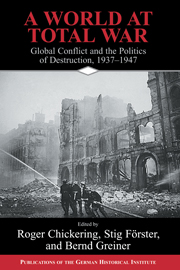Book contents
- Frontmatter
- Are We There Yet? World War II and the Theory of Total War
- Part A The Dimensions of War
- Part B Combat
- Part C Mobilizing Economies
- Part D Mobilizing Societies
- Part E The War against Noncombatants
- Part F Criminal war
- 17 Sexual Violence and Its Prosecution by Courts Martial of the Wehrmacht
- 18 Ideologies of Difference and the Turn to Atrocity: Japan’s War on China
- 19 On the Road to Total Retribution? The International Debate on the Punishment of War Crimes, 1872-194
- 20 Total War: Some Concluding Reflections
- Index
18 - Ideologies of Difference and the Turn to Atrocity: Japan’s War on China
Published online by Cambridge University Press: 05 January 2013
- Frontmatter
- Are We There Yet? World War II and the Theory of Total War
- Part A The Dimensions of War
- Part B Combat
- Part C Mobilizing Economies
- Part D Mobilizing Societies
- Part E The War against Noncombatants
- Part F Criminal war
- 17 Sexual Violence and Its Prosecution by Courts Martial of the Wehrmacht
- 18 Ideologies of Difference and the Turn to Atrocity: Japan’s War on China
- 19 On the Road to Total Retribution? The International Debate on the Punishment of War Crimes, 1872-194
- 20 Total War: Some Concluding Reflections
- Index
Summary
[W]e must show that each time a head is cut off or an eye put out in Vietnam and in France they accept the fact, each time a little girl is raped and in France they accept the fact, each time a Madagascan is tortured and in France they accept the fact, civilization acquires another dead weight, a universal regression takes place, a gangrene sets in, a center of infection begins to spread; and that at the end of all these treaties that have been violated, all these lies that have been propagated, all these punitive expeditions that have been tolerated, all these prisoners who have been tied up and “interrogated,” all these patriots who have been tortured, at the end of all the racial pride that has been encouraged, all the boastfulness that has been displayed, a poison has been instilled into the veins of Europe and, slowly but surely, the continent proceeds toward savagery.
Aime Cesaire, Discourse on ColonialismThe central argument of this essay is that ideologies of difference and hate crimes are produced from and enacted within a variety of social contexts. The context of total war harnessed these to the full instrumentality of the total war state, meaning that mechanisms of social and spiritual mobilization rendered entire populations complicit in acts of racial violence committed by the state. Moreover, under regimes of total warfare, the total war state repressed dissent and refusal. This provided the conditions of possibility for atrocities on a colossal scale such as the Final Solution and the Nanking Massacre, or the fire and atomic bombing of Japanese cities. Although conditions of total war make war crimes more egregious and allow them to expand to an enormous and horrifying scale, a critical genealogy of the atrocities of World War II brings us to other moments and different contexts.
- Type
- Chapter
- Information
- A World at Total WarGlobal Conflict and the Politics of Destruction, 1937–1945, pp. 333 - 354Publisher: Cambridge University PressPrint publication year: 2004



